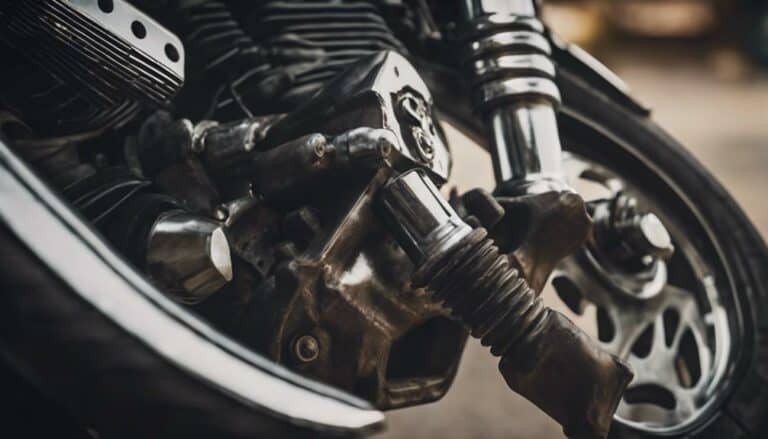When preparing to jack up your Harley Davidson, ensuring stability and safety are paramount. Imagine effortlessly lifting your bike, ready for maintenance or customization tasks, without any risk of it toppling over.
By understanding the correct jacking points and techniques, you can confidently elevate your Harley Davidson to access hard-to-reach areas.
Stay tuned to discover the best practices for securing your bike and completing the jacking process with ease and precision.
Key Takeaways
- Use proper tools like a car jack and wooden plank for safe Harley Davidson maintenance.
- Identify designated jacking points on frame rails to prevent damage during lifting.
- Securely lift the motorcycle by stabilizing with a ramp, straps, and jack stands.
- Lower the bike carefully by ensuring stability, using a ramp, and slowly lowering with a car jack.
Tools Needed for Jacking Up
To properly jack up a Harley Davidson, you'll need specific tools such as a car jack, a wooden plank, straps for securing the bike, and a ramp for lifting the rear wheel. When undertaking maintenance tasks on your Harley Davidson, it's crucial to make sure you have these tools at your disposal to ensure a safe and efficient process.
The car jack plays a vital role in lifting the bike, providing the necessary elevation for maintenance procedures. Additionally, the wooden plank aids in creating clearance under the frame for proper jack placement, ensuring stability during the lifting process.
Securing the bike is paramount, which is why using straps is essential. These straps help in keeping the motorcycle steady and in place after it has been lifted, preventing any accidents or mishaps.
Lastly, the ramp is utilized for lifting the rear wheel, granting easy access to the underside of the Harley Davidson for maintenance or repairs. Having these tools ready and knowing how to use them correctly is fundamental for any Harley Davidson owner looking to perform maintenance or customization tasks with ease.
Locating the Jacking Points
Underneath your Harley Davidson, you'll find frame rails that serve as designated jacking points for lifting the bike. These frame rails run parallel to the ground and are crucial for proper positioning of the jack. Identifying markers on the frame rails, such as notches or grooves, can aid in locating the exact points where the jack should be placed.
Proper positioning of the jack is essential to ensure the weight of the motorcycle is evenly distributed during lifting. Placing the jack at the designated jacking points helps prevent damage to the bike's frame and components. Consult your Harley Davidson manual for specific guidance on locating the jacking points for your model, as different models may have variations in their frame structure.
Lifting the Motorcycle Safely
Locating the proper jacking points on your Harley Davidson ensures a safe and stable lift, allowing you to work on the motorcycle with confidence. To lift your Harley Davidson safely, follow these key steps:
- Lifting technique and Safety precautions: Before starting, ensure the bike is on a stable surface to prevent accidents. Use a ramp to lift the rear wheel, making accessing the frame easier. Stabilize the bike by placing a wooden chalk under the jiffy stand to avoid tipping during the lifting process.
- Weight distribution and Jacking height: Position the car jack under the frame rails with care to prevent structural damage. Proper weight distribution is crucial for a stable lift. Adjust the jack's height to ensure an even lift without straining any part of the motorcycle.
- Jack stand placement and Ground clearance: Once the motorcycle is lifted, secure it with straps to prevent any movement. When placing the jack stands, ensure they're positioned correctly to support the bike securely. Consider the ground clearance when choosing the jack stand placement for added stability.
Securing the Jack Stands
Position the jack stands under the frame of your Harley Davidson, ensuring they are rated for the bike's weight and placed near the front and rear for even weight distribution. Once you have carefully lowered the bike onto the jack stands, it is crucial to check the stability before proceeding with any maintenance tasks. To emphasize the importance of stability and proper positioning, refer to the table below:
| Stability Check | Proper Positioning | Weight Distribution |
|---|---|---|
| Rock bike gently side to side and front to back to ensure jack stands are secure. | Place jack stands under the frame, near the front and rear, for even weight distribution. | Use jack stands rated for the weight of your Harley Davidson for stability. |
Lowering the Harley Davidson
To lower a Harley Davidson for maintenance, utilize a car jack to elevate the rear wheel off the ground. Follow these steps to ensure a smooth process:
- Stabilizing the Bike: Before lifting the rear wheel, make sure the motorcycle is stable and won't tip over during the procedure. This can be achieved by having someone assist you or using additional support mechanisms.
- Raising the Back Wheel onto a Ramp: Once the bike is stable, carefully raise the back wheel onto a suitable ramp to provide clearance for maintenance tasks. Ensure the ramp is secure and can bear the weight of the motorcycle.
- Using a Wooden Chalk: To add an extra layer of stability, place a wooden chalk under the jiffy stand. This will prevent any unnecessary movement of the bike while you work on lowering it.
Conclusion
In conclusion, successfully jacking up a Harley Davidson requires precision and attention to detail. By following the outlined steps and using the necessary tools, you can ensure a safe and efficient lifting process.
Remember, safety is paramount when working on motorcycles, so always double-check your equipment and secure the bike properly. With these tips, you'll be raising your Harley with ease, making it feel as light as a feather on your way to maintenance success.

